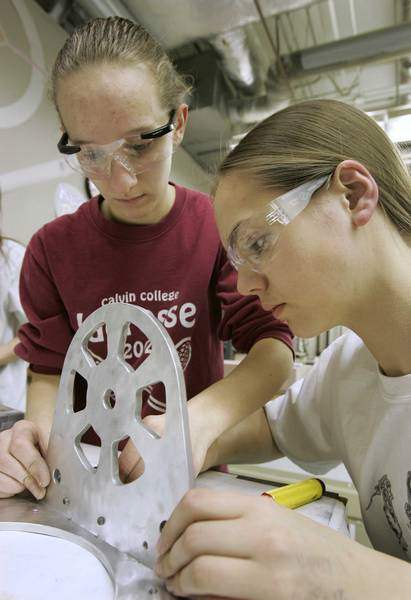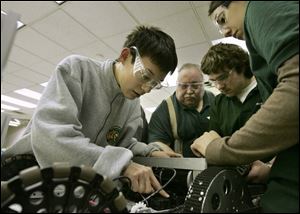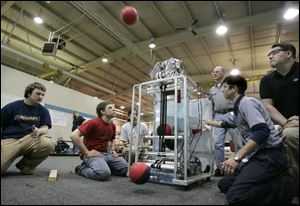
Robotics teams get ready for competition
3/8/2006
Samantha Mozena and Rachel Becker, from left at left, work on the robot's ball-shooting mechanism. The robotics regional competition starts tomorrow at Eastern Michigan University. The students have been working long hours.

Toledo Technology Academy student Samuel Martin, left, works on the drive train of his team's robot. With him are teacher Tom McNutt and students Patrick Berning and Ericka Bilby, who also attend TTA.
Look at the schedule.
No, wait, don't look at the schedule. The schedule is just a plan. A template. An ideal.
But the schedule says all this work was supposed to be done a week ago. By now, students on the Toledo Public Schools robotics team were to be testing. It was to be a week of tweaking, of perfecting, of fine tuning.
Ha!
"Oh, this isn't bad," Bruce Vanisacker said two weeks ago. Mr. Vanisacker is a senior designer at the Dana Technical Resource Park in Ottawa Lake, Mich. It's the night before the Tech Fusion Team 279 must send its robot to regional competition, which runs tomorrow through Saturday on the Eastern Michigan University campus in Ypsilanti.

Students from Toledo Technology Academy and their advisors fire test basketball shots with the robot that they've made. They are, from left, Patrick Berning, Andy Breed, Ericka Bilbey, Jim Smith, Josh Hydrew, and Paul Klevann.
Six weeks ago, the folks at FIRST Robotics Competition announced this year's rules to teams around the world. FIRST - For Inspiration and Recognition of Science and Technology - is the brainchild of Segway creator Dean Kamen.
Initially, the Toledo group met a few times a week. But this is crunch time. No one has had a day off in 16 to 17 days. On weekends, 17-hour days are normal.
But Mr. Vanisacker has been through this seven times before.
It's only hours to deadline, but it's too early to panic.
"We've had years where we put parts in a box and finished building at the competition."
Mr. Vanisacker is one of 13 adults working with 18 students from the Toledo Technology Academy and Rogers High School to create a robot that will move faster, scoop up foam balls better, and shoot with sharper accuracy than all contenders in a three-on-three robot basketball game. Winners go to nationals in Atlanta.
The Ottawa Lake Dana facility isn't the only place where students are losing sleep. Over at a Dana facility in Maumee, a group from Sylvania's Northview High School scramble over their robot, Darkside.

Samantha Mozena and Rachel Becker, from left at left, work on the robot's ball-shooting mechanism. The robotics regional competition starts tomorrow at Eastern Michigan University. The students have been working long hours.
"We're lacking in experience. We're lacking in manpower," says Andy Roth, the Northview chemistry teacher leading the Sylvania team. But he's still feeling pretty good about their chances.
Back at the Ottawa Lake facility, the TPS students stay focused.
Mark Frazier, 15, exudes an off-hand confidence. He's a sophomore at the Toledo Technical Academy. Two weeks ago, he sat on the floor in a Dana lab creating machine parts with an advanced computer-assisted design program.
Today, though, Mark is wedging his shoulder inside the robot, clipping the ends off plastic tabs that hold corrugated plastic boards in place.
"I spent three weeks designing a metal thingy" - Mark is too absorbed in the chore of the moment to come up with a better name - "and now, it's not even here." The metal thingy, a metal plate, was purged in the effort to create a robot that weighs less than 120 pounds. Under such pressure, metal thingies vanish.
"No big thing," Mark says.
Ericka Bilby, a sophomore at the technical academy, and Andy Breed, also sophomore there, devoted a lot of time to robot weight reduction. That meant drilling a swiss cheese of holes into nearly every metal piece on the robot.
Even the plastic clipping Mark engages in now is part of the team's near-manic effort to reduce weight.
"You don't need to do that," a team mentor says. Little plastic strings don't add even grams.
Patrick Berning, a technical academy junior, gives him a half-serious look.
"Too much weight," he declares, and Mark keeps clipping.
Next, the team hoists the robot onto a wagon. Their creation looks like no robot Hollywood ever imagined. Picture instead a large white box with sundry metal parts protruding.
"Let's roll, we're running out of time," exhorts Jim Smith, an engineer at Dana. The students trot down the hall to the practice field.
The robot hulks at midcourt, maybe 12 feet from its target, a 30-inch hole in a vertical board some 6 feet off the ground. Kris Bahnsen, a senior at the technical academy, starts the robot.
A ball rises on a conveyor inside the robot, slow but steady. Just before the ball reaches the firing arm, it hangs up.
Three times they try to fix it.
Finally, on the fourth try, after many adjustments, three balls shoot in quick succession. Two go through the target.
There is no shouting. No celebration.
Then a belt breaks.
No one moans.
Instead, students race the robot over to the scale.
"It's 130," Patrick Berning says. "We're 10 pounds over."
"Take the battery out," Mr. Vanisaker says. Battery weight doesn't count. "You guys are killing me."
"118," Patrick calls.
"All right guys!" Mr. Vanisacker calls out.
The students rush down the hall with the wagon-loaded robot.
The students swarm around it. It's going to be another long night. There will be more testing. More practice. More work.
No one is complaining.
This is how they learn, Mr. Vanisacker says.
"If you want to be champions, you can't do that in your leisure time," he says.
Contact Jenni Laidman at:
jenni@theblade.com
or 419-724-6507.